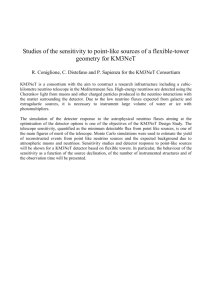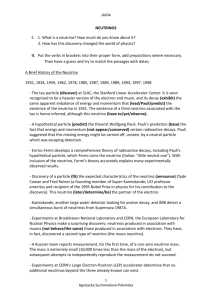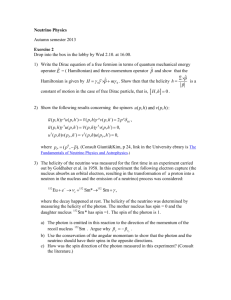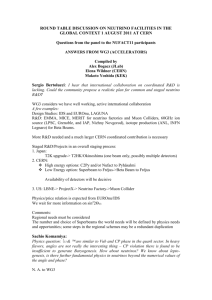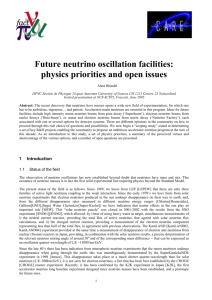Neutrino Physics in Finland - Indico
advertisement
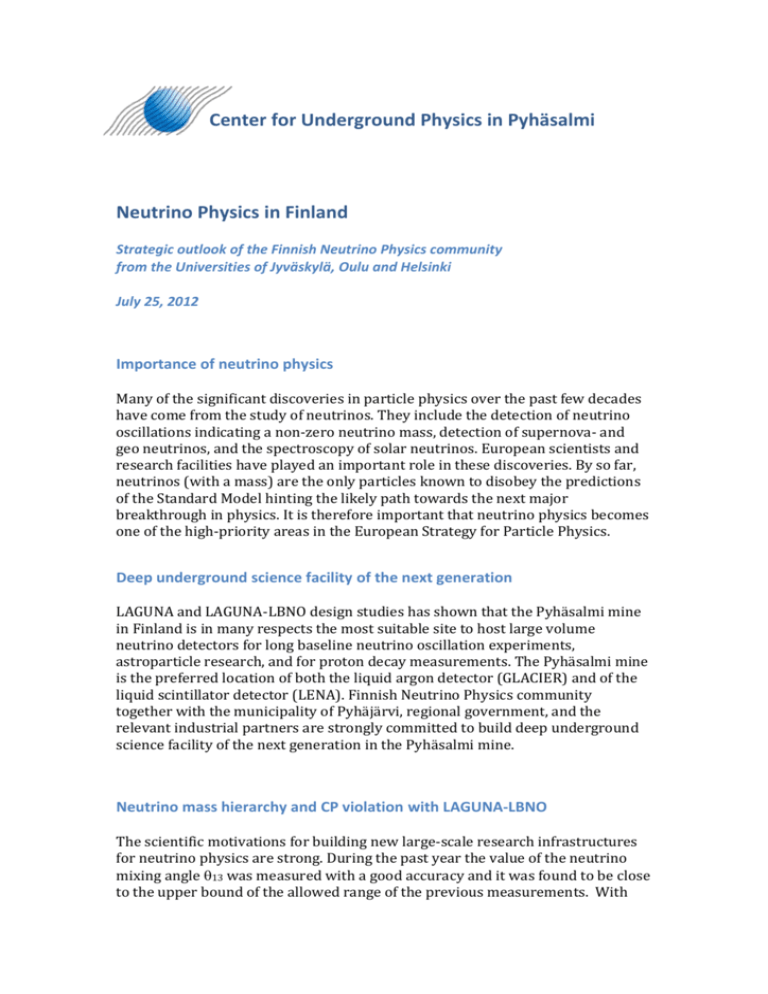
Center for Underground Physics in Pyhäsalmi Neutrino Physics in Finland Strategic outlook of the Finnish Neutrino Physics community from the Universities of Jyväskylä, Oulu and Helsinki July 25, 2012 Importance of neutrino physics Many of the significant discoveries in particle physics over the past few decades have come from the study of neutrinos. They include the detection of neutrino oscillations indicating a non-zero neutrino mass, detection of supernova- and geo neutrinos, and the spectroscopy of solar neutrinos. European scientists and research facilities have played an important role in these discoveries. By so far, neutrinos (with a mass) are the only particles known to disobey the predictions of the Standard Model hinting the likely path towards the next major breakthrough in physics. It is therefore important that neutrino physics becomes one of the high-priority areas in the European Strategy for Particle Physics. Deep underground science facility of the next generation LAGUNA and LAGUNA-LBNO design studies has shown that the Pyhäsalmi mine in Finland is in many respects the most suitable site to host large volume neutrino detectors for long baseline neutrino oscillation experiments, astroparticle research, and for proton decay measurements. The Pyhäsalmi mine is the preferred location of both the liquid argon detector (GLACIER) and of the liquid scintillator detector (LENA). Finnish Neutrino Physics community together with the municipality of Pyhäjärvi, regional government, and the relevant industrial partners are strongly committed to build deep underground science facility of the next generation in the Pyhäsalmi mine. Neutrino mass hierarchy and CP violation with LAGUNA-LBNO The scientific motivations for building new large-scale research infrastructures for neutrino physics are strong. During the past year the value of the neutrino mixing angle 13 was measured with a good accuracy and it was found to be close to the upper bound of the allowed range of the previous measurements. With this knowlegde, the strategy should now focus on the next milestones: determination of the neutrino mass hierarchy and the phase δ of the CP violation in the leptonic sector. The fastest path towards these goals is being prepared by LAGUNA-LBNO – a consortium of 300 scientists and engineers from 13 countries making plans for a very long baseline flavor oscillations experiment with neutrino beams from CERN to Pyhäsalmi mine. The recently submitted Expression of Interest to CERN SPS Committee is the first major milestone towards the realization of this project. The Finnish Neutrino physics community gives this project the highest strategic priority. LAGUNA-LBNO and the High Intensity Frontier Progress in experimental particle physics relies on the increase in energy and intensity of the accelerated ions. It is clear that without the improved luminosity at LHC the recent discovery of the new (Higgs) boson would not have been possible. The proposed neutrino beam from CERN to Pyhäsalmi (CN2PY) would generate the drive to boost the beam power of the existing facilities and pave the way towards the ultimate high-intensity neutrino research facility, the Neutrino Factory. The distance between CERN and Pyhäsalmi mine is not just well suited for CN2PY, the 2300 km long baseline would be ideal for the beams produced by a Neutrino Factory as well. Significance of LENA to LBNO and astroparticle physics Although the primary detector for LBNO experiment is a liquid argon detector with ancillary magnetized iron detector modules behind it, there is a lot of synergy and sound physics reasons to provide the underground laboratory also with a 50 kton liquid scintillator detector LENA. There is a very rich astroparticle program to be accomplished by LENA that includes solar, supernova and geo neutrinos. Also some of the proton decay channels can be best explored with a large scintillator. Even for the beam measurements LENA would have, with a longer run time, the capability of an independent verification of the mass hierarchy and a limited capacity to probe of the range of the leptonic CP phase δ. Last but certainly not least, a liquid scintillator detector is considered to be an excellent tool to investigate the hypothesis of sterile neutrinos produced with high-strength radioactive sources. Kimmo Kainulainen, Jukka Maalampi, Jouni Suhonen and Wladyslaw Trzaska Department of Physics, University of Jyväskylä Marko Aittola, Timo Enqvist, Eelis Kokko and Pasi Kuusiniemi Oulu Southern Institute, University of Oulu Katri Huitu and Kari Rummukainen Department of Physics, University of Helsinki 2
